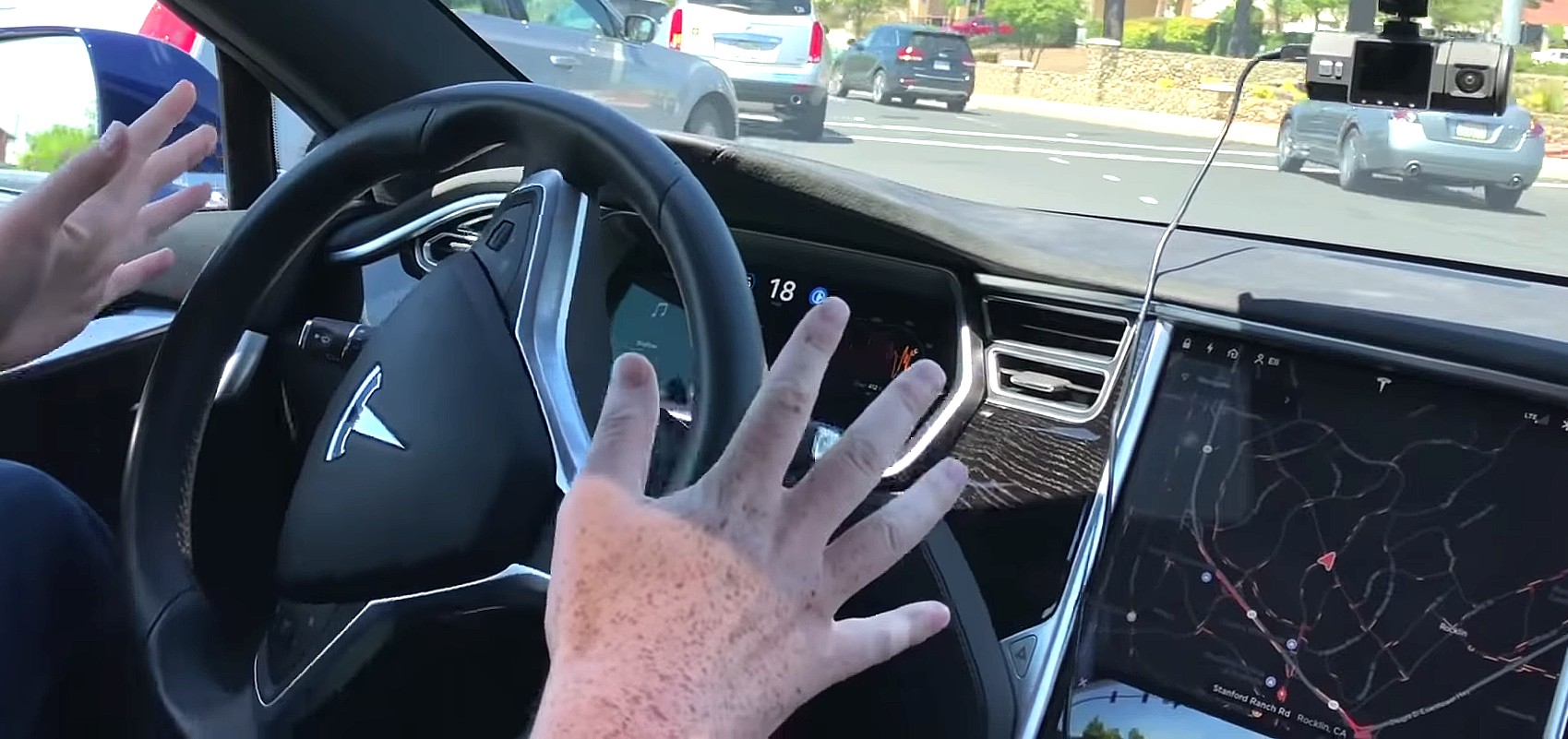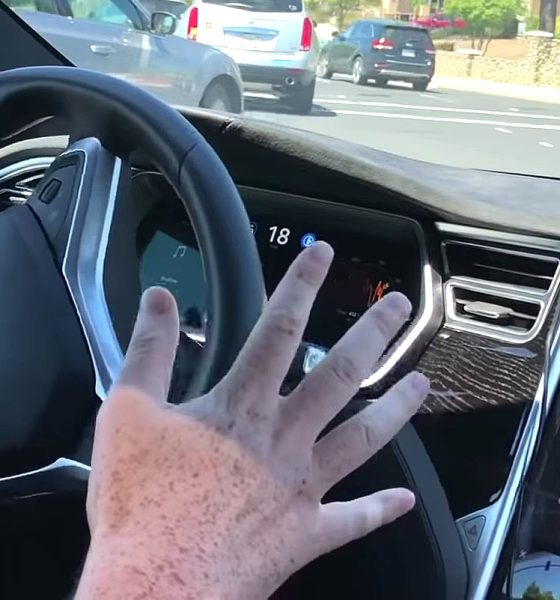

News
Experts’ dismissal of Tesla’s Full Self Driving push proves Elon Musk is still not taken seriously
Despite delays, Elon Musk remains optimistic that Tesla’s efforts to achieve Full Self Driving will bear fruit soon. This was highlighted in a statement during his appearance at the recently held 2020 World Artificial Intelligence Conference in China, where he noted that Tesla is closing in on “Level 5” functionalities. Experts in the field of automation beg to differ.
In a recent statement to Automotive News, Sam Abuelsamid, principal analyst at Guidehouse Insights (formerly Navigant Research) and Missy Cummings, director of the Humans and Autonomy Laboratory at Duke University, openly dismissed Tesla’s efforts to achieve full self driving. In a scathing rebuke, Abuelsamid described Musk’s targets as absurd. He also expressed his pessimism about Tesla’s approach to automation, which focuses on vision and artificial intelligence.
“The cars they are building will never be Level 5, period. It’s nonsense. He needs to shut up until he can deliver something. The premise of making highly automated systems on cameras alone is fundamentally flawed. Their approach to software doing end-to-end AI systems is almost certainly not going to work. I don’t believe it can work. AI is too brittle,” he said.
It should be noted that Abuelsamid recently published a study ranking companies that are currently pursuing autonomy. Similar to studies conducted by Guidehouse Insights when it was still operating as Navigant Research, Abuelsamid ranked Tesla dead last, even behind startups like Navya, which have limited real world driving data.
Abuelsamid’s sentiments were echoed by Missy Cummings, who also argued that there is no way that Tesla could achieve Level 5 autonomy with its vehicles. In a statement to KCBS Radio, Cummings noted that Elon Musk likely does not understand what Level 5 Automation really is. This is an interesting comment from the director of the Humans and Autonomy Laboratory at Duke University, considering that Waymo CEO John Krafcik noted last year that ultimately, “Level 5 is a bit of a myth.”
“There is no way, shape, or form the car is going to be Level 5. He doesn’t really understand what Level 5 is. I think what he means is Level 4, and he’s not even going to get Level 4. The perception systems don’t work well in weather conditions, with long shadows. We know the Tesla perception system, and the news is it’s a really bad system,” she remarked.
While there is some merit in criticizing the Tesla CEO for missing his targets with regards to the release of the electric car maker’s full self driving system, it seems far too careless to simply dismiss all the work that Tesla has accomplished over the years either. The company, after all, is gathering real world driving data at an unprecedented scale that’s unrivaled by companies like Waymo, and that matters much when it comes to training neural networks, as emphasized by ARK Invest CEO Cathie Wood. Tesla’s vision based approach to autonomy has also gained support from notable names such as George Hotz, who believes that Tesla would eventually become the Apple of self driving cars.
It is unfortunate, but based on the dismissive and almost aggressive rebuke of Tesla’s efforts from the experts tapped by Automotive News, it appears there is still a general tendency to completely dismiss Elon Musk and his initiatives. Interestingly enough, these statements are pretty familiar to those who have followed the SpaceX and Tesla story over the years. It may be difficult to recall at this point, but there was a time when it was believed that landing the Falcon 9 first stage on land and an autonomous barge on the sea is impossible. There was also a time when the Model X was considered unbuildable.
Fortunately, Tesla and its CEO are a stubborn bunch, and it takes a lot more than skepticism to discourage the company. This is especially notable considering that Tesla is currently looking to roll out a massive rewrite of its Autopilot suite, which should take the company even closer to full self driving. Perhaps this time around, Elon Musk’s statements about Level 5 Autonomy may actually be pretty accurate, at least in terms of its features and timeframe.
“I’m extremely confident that level five or essentially complete autonomy will happen, and I think, will happen very quickly,” said Musk, answering another question. I think at Tesla, I feel like we are very close to level five autonomy. I think—I remain confident that we will have the basic functionality for level five autonomy complete this year,” Musk said at the 2020 WAIC.

Elon Musk
Elon Musk’s X will start using a Tesla-like software update strategy
The initiative seems designed to accelerate updates to the social media platform, while maintaining maximum transparency.

Elon Musk’s social media platform X will adopt a Tesla-esque approach to software updates for its algorithm.
The initiative seems designed to accelerate updates to the social media platform, while maintaining maximum transparency.
X’s updates to its updates
As per Musk in a post on X, the social media company will be making a new algorithm to determine what organic and advertising posts are recommended to users. These updates would then be repeated every four weeks.
“We will make the new 𝕏 algorithm, including all code used to determine what organic and advertising posts are recommended to users, open source in 7 days. This will be repeated every 4 weeks, with comprehensive developer notes, to help you understand what changed,” Musk wrote in his post.
The initiative somewhat mirrors Tesla’s over-the-air update model, where vehicle software is regularly refined and pushed to users with detailed release notes. This should allow users to better understand the details of X’s every update and foster a healthy feedback loop for the social media platform.
xAI and X
X, formerly Twitter, has been acquired by Elon Musk’s artificial intelligence startup, xAI last year. Since then, xAI has seen a rapid rise in valuation. Following the company’s the company’s upsized $20 billion Series E funding round, estimates now suggest that xAI is worth tens about $230 to $235 billion. That’s several times larger than Tesla when Elon Musk received his controversial 2018 CEO Performance Award.
As per xAI, the Series E funding round attracted a diverse group of investors, including Valor Equity Partners, Stepstone Group, Fidelity Management & Research Company, Qatar Investment Authority, MGX, and Baron Capital Group, among others. Strategic partners NVIDIA and Cisco Investments also continued support for building the world’s largest GPU clusters.
News
Tesla FSD Supervised wins MotorTrend’s Best Driver Assistance Award
The decision marks a notable reversal for the publication from prior years, with judges citing major real-world improvements that pushed Tesla’s latest FSD software ahead of every competing ADAS system.

Tesla’s Full Self-Driving (Supervised) system has been named the best driver-assistance technology on the market, earning top honors at the 2026 MotorTrend Best Tech Awards.
The decision marks a notable reversal for the publication from prior years, with judges citing major real-world improvements that pushed Tesla’s latest FSD software ahead of every competing ADAS system. And it wasn’t even close.
MotorTrend reverses course
MotorTrend awarded Tesla FSD (Supervised) its 2026 Best Tech Driver Assistance title after extensive testing of the latest v14 software. The publication acknowledged that it had previously criticized earlier versions of FSD for erratic behavior and near-miss incidents, ultimately favoring rivals such as GM’s Super Cruise in earlier evaluations.
According to MotorTrend, the newest iteration of FSD resolved many of those shortcomings. Testers said v14 showed far smoother behavior in complex urban scenarios, including unprotected left turns, traffic circles, emergency vehicles, and dense city streets. While the system still requires constant driver supervision, judges concluded that no other advanced driver-assistance system currently matches its breadth of capability.
Unlike rival systems that rely on combinations of cameras, radar, lidar, and mapped highways, Tesla’s FSD operates using a camera-only approach and is capable of driving on city streets, rural roads, and freeways. MotorTrend stated that pure utility, the ability to handle nearly all road types, ultimately separated FSD from competitors like Ford BlueCruise, GM Super Cruise, and BMW’s Highway Assistant.
High cost and high capability
MotorTrend also addressed FSD’s pricing, which remains significantly higher than rival systems. Tesla currently charges $8,000 for a one-time purchase or $99 per month for a subscription, compared with far lower upfront and subscription costs from other automakers. The publication noted that the premium is justified given FSD’s unmatched scope and continuous software evolution.
Safety remained a central focus of the evaluation. While testers reported collision-free operation over thousands of miles, they noted ongoing concerns around FSD’s configurable driving modes, including options that allow aggressive driving and speeds beyond posted limits. MotorTrend emphasized that, like all Level 2 systems, FSD still depends on a fully attentive human driver at all times.
Despite those caveats, the publication concluded that Tesla’s rapid software progress fundamentally reshaped the competitive landscape. For drivers seeking the most capable hands-on driver-assistance system available today, MotorTrend concluded Tesla FSD (Supervised) now stands alone at the top.
News
Elon Musk’s Grokipedia surges to 5.6M articles, almost 79% of English Wikipedia
The explosive growth marks a major milestone for the AI-powered online encyclopedia, which was launched by Elon Musk’s xAI just months ago.

Elon Musk’s Grokipedia has grown to an impressive 5,615,201 articles as of today, closing in on 79% of the English Wikipedia’s current total of 7,119,376 articles.
The explosive growth marks a major milestone for the AI-powered online encyclopedia, which was launched by Elon Musk’s xAI just months ago. Needless to say, it would only be a matter of time before Grokipedia exceeds English Wikipedia in sheer volume.
Grokipedia’s rapid growth
xAI’s vision for Grokipedia emphasizes neutrality, while Grok’s reasoning capabilities allow for fast drafting and fact-checking. When Elon Musk announced the initiative in late September 2025, he noted that Grokipedia would be an improvement to Wikipedia because it would be designed to avoid bias.
At the time, Musk noted that Grokipedia “is a necessary step towards the xAI goal of understanding the Universe.”
Grokipedia was launched in late October, and while xAI was careful to list it only as Version 0.1 at the time, the online encyclopedia immediately earned praise. Wikipedia co-founder Larry Sanger highlighted the project’s innovative approach, noting how it leverages AI to fill knowledge gaps and enable rapid updates. Netizens also observed how Grokipedia tends to present articles in a more objective manner compared to Wikipedia, which is edited by humans.
Elon Musk’s ambitious plans
With 5,615,201 total articles, Grokipedia has now grown to almost 79% of English Wikipedia’s article base. This is incredibly quick, though Grokipedia remains text-only for now. xAI, for its part, has now updated the online encyclopedia’s iteration to v0.2.
Elon Musk has shared bold ideas for Grokipedia, including sending a record of the entire knowledge base to space as part of xAI’s mission to preserve and expand human understanding. At some point, Musk stated that Grokipedia will be renamed to Encyclopedia Galactica, and it will be sent to the cosmos.
“When Grokipedia is good enough (long way to go), we will change the name to Encyclopedia Galactica. It will be an open source distillation of all knowledge, including audio, images and video. Join xAI to help build the sci-fi version of the Library of Alexandria!” Musk wrote, adding in a later post that “Copies will be etched in stone and sent to the Moon, Mars and beyond. This time, it will not be lost.”








